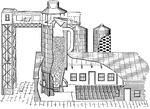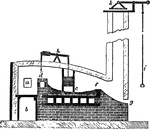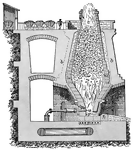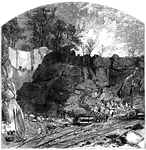Clipart tagged: ‘ore’

Arrastre
"Mexican Arrastre. A rude apparatus used in Mexico, and to some extent in the United States, for grinding…

Blast Furnace
A blast furnace measuring 42 feet high and 15 feet across that contains 4356 cubic feet of space.

Blast Furnace
A blast furnace measuring 47.5 feet high and 16.5 feet across that contains 6174 cubic feet of space.

Blast Furnace
A blast furnace measuring 55 feet high and 16 feet across that contains 7175 cubic feet of space.

Blast Furnace
A blast furnace measuring 58 feet high and 17 feet across that contains 8000 cubic feet of space.

Blast Furnace
A blast furnace measuring 60 feet high and 20 feet across that contains 12778 cubic feet of space.
Blast Furnace
A blast furnace measuring 75 feet high and 16.5 feet across that contains 11983 cubic feet of space.

Blast Furnace
A blast furnace measuring 80 feet high and 20.5 feet across that contains 15500 cubic feet of space.
Blast Furnace
A blast furnace measuring 95.5 feet high and 16 feet across that contains 15050 cubic feet of space.
Blast Furnace
A blast furnace measuring 95.5 feet high and 22 feet across that contains 25940 cubic feet of space.
Blast Furnace
A blast furnace measuring 95.5 feet high and 24 feet across that contains 28950 cubic feet of space.

Blast Furnace
A blast furnace measuring 85 feet high and 25 feet across that contains 26000 cubic feet of space.

Blast Furnace
A blast furnace measuring 90 feet high and 30 feet across that contains 41149 cubic feet of space.

Blast Furnace for Cast Iron
"Iron ores are smelted in a blast furnace which is operated in a manner similar to that employed in…

Collecting Top
"Prior to the introduction of the cup and cone, a form of tunnel-head in which no valve or cone exists…

Diabantite
"Diabantite, ore material, and agate in vesicle of main basalt. The radial mass occupying the center…

Frue Vanner (Side View)
A Frue Vanner is a shaking, rubber belt used to concentrate gold ore 'pulp'.

Ore Crushing Machine
A crusher is a machine designed to reduce large rocks into smaller rocks, gravel, or rock dust. Crushers…

Mechanical Rabble
"A representation of one of the class of mechanical rabbles known as Witham's machine rabble applied…

Pernot Furnace
"Pernot and Ponsard Furnaces and Allied Appliances. The pernot furnace as applied to the steel making…

Puddling Furnace
"The general arrangement of a puddling furnace; a is the charging door for the fuel, d the bridge with…

Puddling Furnace
"The general arrangement of a puddling furnace; a is the charging door for the fuel, d the bridge with…

Refinery
"The term "refining," although in strictness applicable to all methods by which impure iron is purified,…

Refinery
"The term "refining," although in strictness applicable to all methods by which impure iron is purified,…

Reverbatory Furnace
Furnace used in smelting ore; its' doors can be closed to control the air flow/oxygen.
Rolling Mills
"Pig iron, the crude form of iron, which is produced from iron ore by the process of blasting, is taken…

Smelting Furnace with Fire Burning
"A furnace in which metals are separated from their ores. a, fire-brick lining; b, masonry; c, opening…




